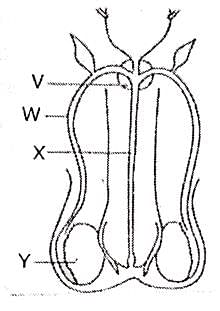Science Olympiad Test: Reproduction in Organism- 2 - Class 10 MCQ
15 Questions MCQ Test Olympiad Preparation for Class 10 - Science Olympiad Test: Reproduction in Organism- 2
Which of the following flower is bisexual
Which one of the following, best describes the function of the umbilical cord?
| 1 Crore+ students have signed up on EduRev. Have you? Download the App |
Which of the following is not a part of human male reproductive system. This is
Reproduction is essential for living organism in order to
In asexual reproduction, two offsprings having the same genetic material and the same body features are called
Which among the following statements are true for unisexual flowers?
(i) They possess both stamen and pistil
(ii) They possess either stamen or pistil
(iii) They exhibit cross pollination
(iv) Unisexual flower possessing only stamens cannot produce fruits
A planaria worm is cut horizontally into two halves P and Q such that the part P contains the whole head of the worm. Another Planaria worm is cut vertically into two halves R and S in such a way that both the cut pieces R and S contain half head each. Which of the two planaria worms could regenerate to form the complete respective worms?
The figure given alongside show the human male reproductive organs, which structures make sperms and seminal fluid?

One of the following process does not lead to the formation of clones. This is
The correct sequence of organs in the male reproductive system for the transport of sperm is
The length of pollen tube depends on the distance between
The ratio of number of chromosomes in a human zygote and a human sperm is
The sexually transmitted disease which is caused by bacteria is
Binary fission describes the type of reproduction where the organism divides to form
The disease kala-azar is caused by a microorganism is known as
|
13 videos|44 docs|187 tests
|
|
13 videos|44 docs|187 tests
|

















